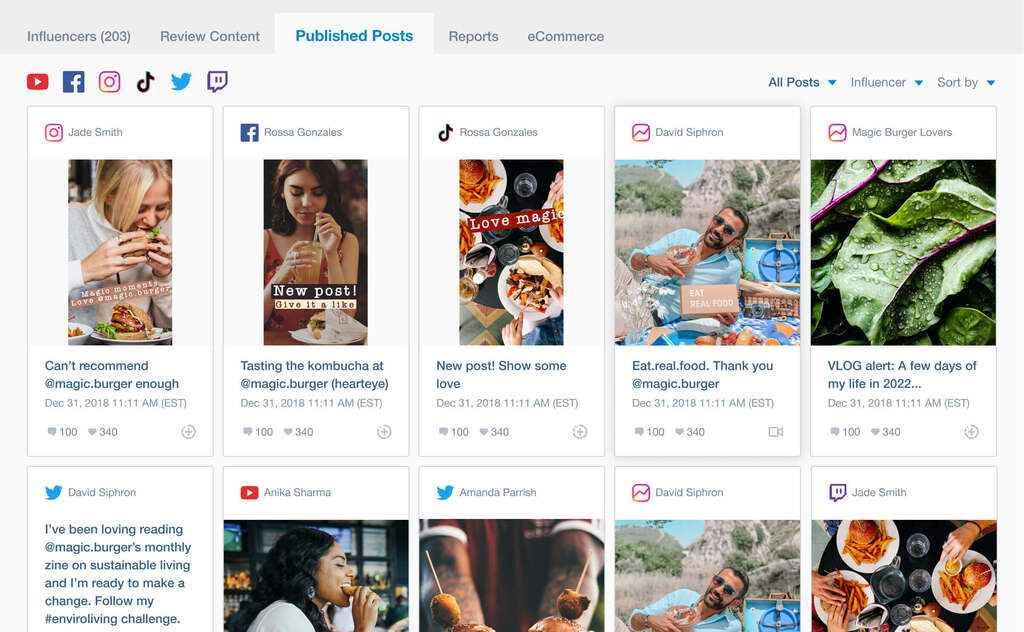Join us and boost your social media potential with our data-led event
Join us and boost your social media potential with our data-led event
If done right, influencer marketing can launch e-commerce brands into success. Working with the correct influencer to promote your products can bring an audience of highly engaged fans to your brand.
According to Influencer Marketing Hub’s 2022 Benchmark Report, 90% of companies believe influencer marketing is a useful tool for increasing brand awareness and sales. With influencer marketing growing in popularity, how can your e-commerce business execute a successful influencer marketing campaign?
Businesses value the return on investment (ROI) of influencer marketing, to the extent that influencer marketing is expected to grow to be worth $16.4 billion in 2022. Why are so many brands doubling down on influencer marketing? Because it works.
One notable example is Mariee Revere, CEO of MoonXCosmetics. Mariee started her company in 2017 as a local business but was forced to switch to an ecommerce model during the pandemic. She launched a website in May 2020, and her products sold out within 30 minutes, generating more than $1,000,000 in sales in just eight minutes.
How did she accomplish that? She worked with influencer Jayda Cheaves to market her skincare products.
Now we’ve covered the benefits of influencer marketing for e-commerce brands, let’s review six steps to create a winning campaign.
In order to properly measure the success of your influencer marketing efforts, you must start by outlining your goals. Here are some potential KPIs:
Understanding your target audience will help you produce content that resonates with your ideal customer. It will also help you to choose appropriate influencers to represent your brand.
To determine who your audience is, build a customer persona. A customer persona (or buyer persona) is a fictional person that is representative of your target audience. To create such a persona, answer these questions:
Knowing your business goals and target audience makes selecting the best social platforms to reach that ideal customer much easier.
Perhaps you want to increase brand awareness, then maybe Instagram or YouTube would be best for you. Do you want to hit a younger audience? Then try TikTok or Snapchat. Keep your audience in mind, and then discover which platforms have a higher number of users with that demographic.
Now you've selected the right social platforms for your campaign, it’s time to identify the perfect influencers. A great place to start is by searching for influencers among your existing customer base. Finding someone currently using your product will make their endorsement that much more special and authentic.
Whether you’re selecting an influencer from your customer base, using an influencer discovery tool, or searching natively on social platforms, ask these questions before reaching out:
Don’t hesitate to use a micro-influencer (an influencer with 10,000 - 50,000 followers). Some micro-influencers can have higher engagement rates and often charge more reasonable rates than their more popular counterparts.
Now you have your ideal influencers in mind, it’s time to reach out and secure a partnership. You can send a short email or direct message to the influencer's social account outlining your brand information, request, and payment options.
The best influencer outreach is always sincere and highly personalized. Make sure to mention an aspect about their online presence which resonates with your brand.
You can compensate influencers for sponsored content in a variety of ways, including free products, special discounts, and, of course, direct payment. Make sure to offer fair compensation based on the work required from the influencer during the campaign.
The final stage is to develop the campaign itself. We recommend encouraging your influencers to create video content whenever possible, because 78% percent of marketers say video has directly helped them increase sales. Viewers are also 2x more likely to share video content with their friends than any other type of content.
An influencer can review your product or make a how-to video, but don’t limit your options to one or two formats. When creating video content, allow your influencer as much freedom and creativity as possible. They may surprise you with the result, and it's often the best way to create something that the audience will find engaging and entertaining. After all, the influencer’s brand is their personality -- that’s how they have amassed such a large following in the first place.
Another useful strategy is to offer the influencer’s followers a discount on your product. The influencer can add a custom discount code to the post description, and followers can apply the coupon at checkout on your e-commerce site.
If possible, ask the influencer to include a direct link to your website or other digital storefront in the post. It saves potential customers an extra step if they're interested in buying your product.
Brandwatch’s influencer marketing software is designed to help e-commerce brands run effective influencer marketing campaigns. From helping your team identify the right influencers to tracking campaign performance in real time, Brandwatch Influence can help you save time, and optimize the success of your influencer marketing initiatives.
Offering up analysis and data on everything from the events of the day to the latest consumer trends. Subscribe to keep your finger on the world’s pulse.
Discover influencers, handle relationships, and manage campaigns — all in one end-to-end solution.
Existing customer?Log in to access your existing Falcon products and data via the login menu on the top right of the page.New customer?You'll find the former Falcon products under 'Social Media Management' if you go to 'Our Suite' in the navigation.
Brandwatch acquired Paladin in March 2022. It's now called Influence, which is part of Brandwatch's Social Media Management solution.Want to access your Paladin account?Use the login menu at the top right corner.

